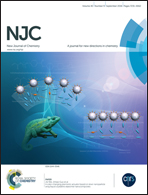Two dpa-based zinc(ii) complexes as potential anticancer agents: nuclease activity, cytotoxicity and apoptosis studies†
Abstract
Two new mononuclear zinc(II) complexes [ZnLX2]2·CH3OH (X = Br for 1, Cl for 2) of a tridentate polypyridyl ligand L (L = 4-methyl-N,N-bis(pyridin-2-ylmethyl)aniline) have been synthesized and structurally characterized. The interactions of two complexes with CT-DNA, pBR322 plasmid DNA and BSA have been explored respectively by using various physico-chemical techniques. Furthermore, the anticancer activities of the complexes towards three human tumor cells lines (HeLa, MCF-7 and RL952) have been studied. The IC50 values of 1 (on MCF-7 cells) and 2 (on RL952 cells) are 12.58 μM and 11.71 μM, respectively. The apoptosis-inducing activity of 1 was assessed by Hoechst 33342 staining, Annexin V binding and cell cycle analyses.


 Please wait while we load your content...
Please wait while we load your content...